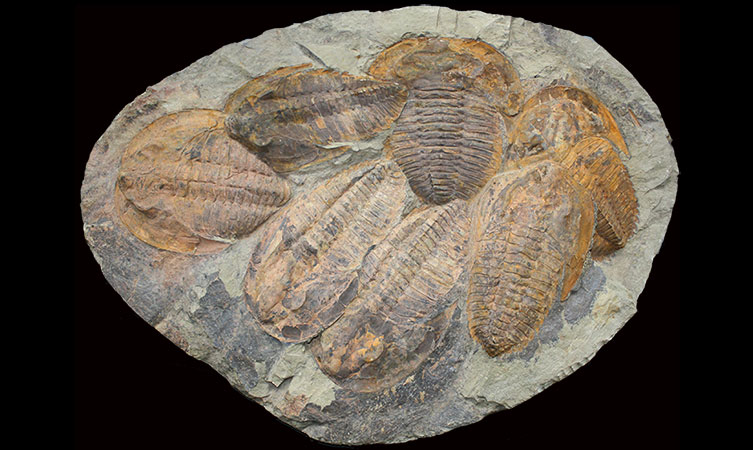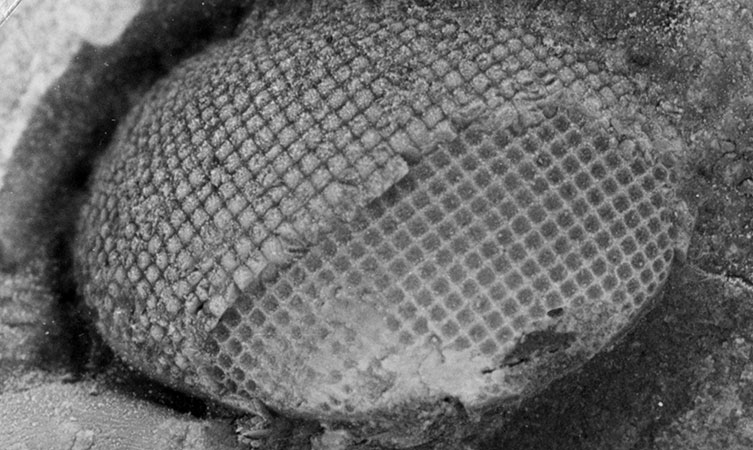Create a list of articles to read later. You will be able to access your list from any article in Discover.
You don't have any saved articles.

Museum palaeontologists observed eyes on stalks and fossilised brain tissue in this very early arthropod from 517 million years ago.
Museum palaeontologists Dr Greg Edgecombe and Dr Xiaoya Ma are using extraordinary fossils to reveal exquisite details about the earliest eyes on Earth.
More than 541 million years ago, during the Precambrian Eon, life existed in a quiet gloom. Most creatures were blind, so colour was of little use. There was no need to be camouflaged, warn off predators or seduce a partner with bright patterns.
Some animals could likely tell the difference between light and dark, but they never knew whether that looming shadow was a friend or foe.
Then, at the beginning of the Cambrian Period, life opened its eyes.
In the 15 million years that followed the evolution of vision, most of the major animal groups we know today appeared. After millions of years of evolutionary idleness, suddenly there was a huge variety of colours, body forms and lifestyles.

Reconstruction of Anomalocaris, a formidable predator from the Cambrian Period
This dramatic increase in animal diversity, 545 to 530 million years ago, is known as the Cambrian explosion.
The evolution of the eye is likely to have been a catalyst for the explosion, initiating an arms race between organisms that were increasingly aware of their surroundings.
Now, with access to uniquely well-preserved Cambrian fossils, Dr Greg Edgecombe and Dr Xiaoya Ma are seeing the evolution of vision through the world's oldest eyes.
To understand the eyes of ancient animals, scientists need the entire visual system: the eyes themselves, plus any connection with the brain that allows processing of visual data.
Unfortunately, that's not so easy to find, as Dr Ma knows all too well:
'When we started our project nobody had found any fossilised neural tissue. The idea was that we go out and search for some.'
Because soft tissues tend to decompose quickly after animals die, only hard parts such as shells and bones are generally preserved in fossils. Neural tissues have traditionally been considered particularly prone to decay.
In 2012, Dr Ma and Dr Edgecombe turned that presumption on its head - and out rolled a brain.
The breakthrough came when they were studying a 517-million-year-old arthropod fossil, Fuxianhuia protensa, from the Chengjiang deposit in China.
The distinctive stalked eyes of this small, sea-dwelling animal had been well studied, but this time the team noticed something unusual.
'In one specimen, we could see a dark structure situated in the front part of the head, with perfectly bilateral symmetry and projecting lobes,' recalls Dr Ma. 'There were tracks coming out of either side of the structure that led into the eye stalks and antennae.'

Close-up of the dark brown brain and neural connections visible in the Fuxianhuia protensa fossil
The dark structure perfectly matched the position and shape of the brain in living relatives of F. protensa, such as lobsters, crabs and insects. The paired tracks were interpreted as nerves.
'It looked like the first-ever fossilised brain from the Cambrian,' says Dr Ma. 'That meant we were looking at the neuroanatomy of very ancient animals, something we couldn't even dream about before.'
Originally discovered in 1984, Chengjiang is a rock deposit that contains exceptionally preserved fossils. These deposits, known as Konservat-Lagerstätten, often preserve fleshy tissue such as soft bodies and appendages, eyes, guts and sometimes even blood vessels.
At 517 million years, Chengjiang is the oldest-known Cambrian site preserving soft-body parts. The more famous Burgess Shale in Canada is younger, at about 508 million years old.
Around 50% of the fossils found in Chengjiang are arthropods, a group that now includes insects, spiders, centipedes and crustaceans. More than 75% of all animals today are arthropods.
F. protensa and other Cambrian relatives of modern arthropods are identified as such by the classic arthropod body plan: an external skeleton, a segmented body and jointed limbs.

Xiaoya Ma (left) looking for fossils at Chengjiang
Three generations of palaeontologists have now studied Chengjiang's fossils, uncovering the physiology of Cambrian animals in stunning detail. Dr Ma and Dr Edgecombe's find was another major breakthrough.
They had found the first brain found preserved in a Cambrian fossil, which became the subject of the first journal publication entirely dedicated to fossilised neural tissue.
'Unfortunately, at the time, we only had that single specimen,' says Dr Ma, 'and the paper quickly caused some controversy. Our solution was to go and look for more evidence.'
Three years later, they finally succeeded in finding it.
In 2015, the team studied nine other F. protensa specimens that showed the same brain-like structures, in matching locations. This proved that their 2012 discovery was a genuine anatomical structure and the animal had already acquired a complex brain.

Overlain patterns of preserved neural tissue in four Fuxianhuia protensa specimens, showing the matching positions
The fossils also showed that the eye stalks were mobile, because they were preserved in different orientations. This means F. protensa could conceivably look in two directions at once and had depth perception.
So even just after the main burst of the Cambrian explosion, arthropods like F. protensa already had a complex visual system.

Fuxianhuia protensa fossils show the stalked eyes in different positions, indicating the animal could move them
Anomalocaris is another early arthropod relative with surprising optics.
The marine animal had giant compound eyes, about the size of a snooker ball in the biggest specimens, set on the end of stalks.
Compound eyes are made up of many repeating units, known as ommatidia, each unit with its own lens and light receptor cells. Using information from each lens and light receptor, the eyes produce a single mosaic image - somewhat like pixels. The more pixels, the sharper the image. Living insects and crustaceans have compound eyes.
In 2011, thanks to some 514-million-year-old fossils from South Australia, Dr Edgecombe and colleagues were able to study the eye surface of Anomalocaris in 3D for the first time.
But the value of the fossils was not immediately apparent.
'The Australian fossils are crushed and aren't as complete as the whole-body specimens from other Lagerstätten deposits like Chengjiang,' explains Dr Edgecombe, 'but they're more three-dimensional.'

Fossilised surface of the compound eye of Anomalocaris and a close-up of the lens details inset
Fossils from the Burgess Shale and Chengjiang may be exceptionally preserved, but they are usually flat, two-dimensional carbon films with little or no surface detail. For complex structures like the eye, palaeontologists want to see in 3D.
In the Australian fossils, minerals replicated the surface structure of the eyes before the lens details were lost to decay.

The compound eyes of Anomalocaris (left) show the same hexagonal lens shape as a modern housefly, Musca domestica, (right) under a high magnification microscope
Looking at one side of the eye using scanning electron microscopy, each member of the team chose a small area and counted the number of lenses. Their counts led them to estimate that each eye of Anomalocaris had at least 16,700.
But that was just one side of the spherical eye surface. If there are also lenses on the other side of the eye, their number could reach a mind-boggling 30,000 lenses.
That puts Anomalocaris in the hall of (eye) fame. Dragonflies are the only living creatures to have a similar number of lenses.
'There's simply no way, with an eye of this size and so many lenses, that this animal did not have highly acute vision,' says Dr Edgecombe.
With 'super vision' and a pair of fearsome grasping appendages, Anomalocaris fits the bill as a formidable predator. It probably used its excellent vision to scout for prey in the ocean, reeling them in with its specialised front claws.

Burgess Shale Anomalocaris fossil, showing the spiny front claw in a specimen loaned by the Royal Ontario Museum
Vision had to start somewhere. We know from fossils like Anomalocaris and F. protensa that there were already complex, well-developed eyes by the Early Cambrian, around 517 million years ago. Before this time, the fossil record is patchy.
'You don't get large body fossils of animals more than about 521 million years ago,' says Dr Edgecombe. 'Before that you're dealing with little scraps of small shelly fossils, little plates and pieces that usually aren't articulated together and also trace fossils.'

Pairs of eyes are visible on the heads of these trilobites, Cambropallas telesto, from 520 million years ago. Trilobite compound eyes are the earliest well-preserved visual surfaces in the fossil record.

Compound eye of Telephina convexa, showing lots of tiny square lenses. This trilobite swam in oceans around 450 million years ago. Enlarged eyes let in more light and provided wrap-around vision.
So how do we work out exactly when and where the first complex, image-forming eyes evolved?
Molecular dating using DNA sequences of living animals predicts that a shared set of genes used to build eyes originated before the start of the Cambrian.
We can’t pinpoint precisely when it happened, but we can estimate how long they took to evolve.
In 1994, Prof Dan-Eric Nilsson of Lund University in Sweden modelled the evolution of a simple layer of light receptors, incapable of seeing much more than light versus dark, to an eye capable of seeing high-resolution images.
His calculations assumed a tiny change with each generation towards a more evolved eye. Typical marine invertebrates can reproduce within their first year of life, so generations proceed rapidly.
Prof Nilsson's 'pessimistic estimate of the time required for an eye to evolve' was less than 364,000 years.
This might seem like a long time, but in evolutionary terms it's incredibly quick - so quick, in fact, that some scientists see it as evidence that eyes sparked the Cambrian explosion.
'The evolution of eyes could certainly have triggered an arms race during the Cambrian Period,' says Dr Ma. 'Eyes give you a huge advantage in terms of being able to navigate, chase the sun, find where the food is, avoid predators and go for prey. Whoever had eyes had a huge advantage over those who didn't.'
Since then, eyes have diversified into the huge range seen in animals today - from worms that can only sense light and dark, to the unparalleled mantis shrimp, which sees colour using 12 to 16 visual pigments (humans have three) and can even process polarised light.
Every one of these eyes begins its story in the Cambrian Period, when the evolution of vision triggered an explosion of diversity of life and changed our world forever.